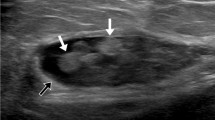Abstract
The goal of this study was to describe the MRI characteristics of posttraumatic pseudolipomas. Ten patients with previous history of blunt trauma or local surgery were investigated with MRI at the level of their deformity. The etiology was blunt trauma in eight patients and postoperative trauma in two. For all patients medical documentation, in the form of clinical history and physical examination, confirmed that a visible hematoma was present acutely at the same location following the injury and that the contour deformity subsequently appeared. All patients underwent liposuction. Preoperative bilateral MRI examinations were performed on all patients. The mean clinical follow-up was 17.8 months. MRI examinations were interpreted in consensus by two experienced musculoskeletal radiologists with attention to fatty extension (subcutaneous fatty thickness and anatomical extension), asymmetry compared with the asymptomatic side, the presence or absence of fibrous septae or nonfatty components, and patterns of contrast enhancement. Ten posttraumatic pseudolipomas were identified. Clinically, they showed as subcutaneous masses with the consistency of normal adipose tissue. Their locations were the abdomen (n=1), hip (n=1), the upper thigh (n=6), the knee (n=1), and the ankle (n=1). On MRI examinations, using the contralateral side as a control, pseudolipomas appeared as focal fatty masses without a capsule or contrast enhancement. Posttraumatic pseudolipomas may develop at a site of blunt trauma or surgical procedures often antedated by a soft tissue hematoma. Characteristic MRI findings are unencapsulated subcutaneous fatty masses without contrast enhancement.




Similar content being viewed by others
References
Kransdorf MJ, Murphey MD (1997) Lipomatous tumours. In: Kransdorf M, Murphey M (eds) Imaging of soft tissue tumours. Saunders, Philadelphia pp 57–101
Adair F, Pack G, Farrior J (1932) Lipomas. Am J Cancer 16:1104
Brooke RI, MacGregor AJ (1969) Traumatic pseudolipoma of the buccal mucosa. Oral Surg Oral Med Oral Pathol 28:223–225
Roberts CC, Liu PT, Colby TV (2003) Encapsulated versus nonencapsulated superficial fatty masses: a proposed MR imaging classification. Am J Roentgenol 180:1419–1422
Abner ML (2001) Lipoma of the abdomen after suction lipectomy. Plast Reconstr Surg 107:293
Copcu E (2003) Can intramuscular lipoma have a post-traumatic origin? Br J Dermatol 149:1084–1085
Meggitt BF, Wilson JN (1972) The battered buttock syndrome—fat fractures. A report on a group of traumatic lipomata. Br J Surg 59:165–169
Herbert DC, DeGeus J (1975) Post-traumatic lipomas of the abdominal wall. Br J Plast Surg 28:303–306
Rozner L, Isaacs GW (1977) The traumatic pseudolipoma. Aust N Z J Surg 47:779–782
Dodenhoff T (1988) Trauma induced saddle bag: case report. Lipoplasty Newsletter 5:55
Elsahy N (1989) Post traumatic fatty deformities. Eur J Plast Surg 12:208
David LR, DeFranzo A, Marks M, Argenta LC (1996) Posttraumatic pseudolipoma. J Trauma 40:396–400
Signorini M, Campiglio GL (1998) Posttraumatic lipomas: where do they really come from? Plast Reconstr Surg 101:699–705
Simango S, Ramdial PK, Madaree A (2000) Subpectoral post-traumatic lipoma. Br J Plast Surg 53:627–629
Cormenzana Olaso P, Martinez Florez A, Cecilia Gomez JA (1982) Lipodistrofia post-traumatica. Ibero-Latinoamer 18:47
Penoff JH (1982) Traumatic lipomas/pseudolipomas. J Trauma 22:63–65
Inampudi P, Jacobson JA, Fessell DP, Carlos RC, Patel SV, Delaney-Sathy LO, van Holsbeeck MT (2004) Soft-tissue lipomas: accuracy of sonography in diagnosis with pathologic correlation. Radiology 233:763–767. Epub 2004 Oct 14. PMID: 15486212
Dietrich O, Raya JG, Sommer J, Deimling M, Reiser MF, Baur-Melnyk A (2004) A comparative evaluation of a RARE-based single-shot pulse sequence for diffusion-weighted MRI of musculoskeletal soft-tissue tumors. Eur Radiol DOI: 10.1007/s00330-004-2619-3
Gielen JL, De Schepper AM, Vanhoenacker F, Parizel PM, Wang XL, Sciot R, Weyler J (2004) Accuracy of MRI in characterization of soft tissue tumors and tumor-like lesions. A prospective study in 548 patients. Eur Radiol 14(12):2320–2330
Einarsdottir H, Karlsson M, Wejde J, Bauer HC (2004) Diffusion-weighted MRI of soft tissue tumours. Eur Radiol 14(6):959–963
Davies AM, Hall AD, Strouhal PD, Evans N, Grimer RJ (2004) The MR imaging appearances and natural history of seromas following excision of soft tissue tumours. Eur Radiol 14(7):1196–1202
Sharma PK, Janniger CK, Schwartz RA, Rauscher GE, Lambert WC (1991) The treatment of atypical lipoma with liposuction. J Dermatol Surg Oncol 17:332–324
Acknowledgement
We acknowledge G. Wintermark for her help in editing this manuscript.
Author information
Authors and Affiliations
Corresponding author
Rights and permissions
About this article
Cite this article
Theumann, N., Abdelmoumene, A., Wintermark, M. et al. Posttraumatic pseudolipoma: MRI appearances. Eur Radiol 15, 1876–1880 (2005). https://doi.org/10.1007/s00330-005-2757-2
Received:
Revised:
Accepted:
Published:
Issue Date:
DOI: https://doi.org/10.1007/s00330-005-2757-2




